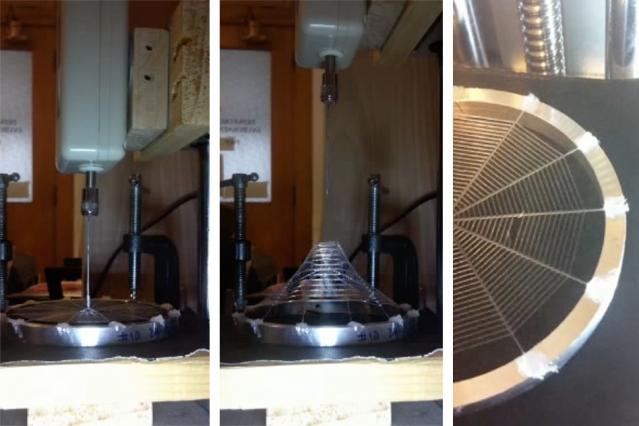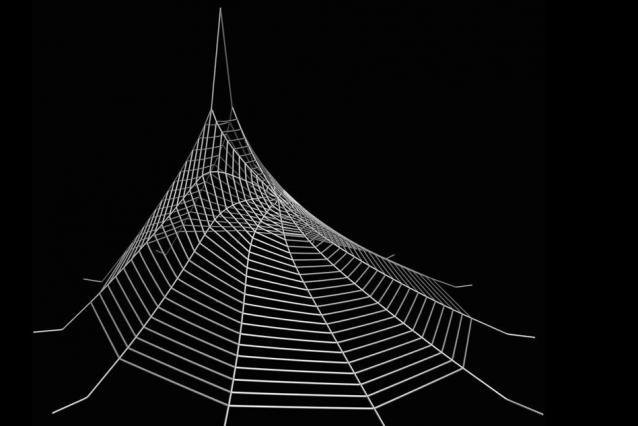 The science of materials is one that often walks in tandem with the technology of 3D printing. Researchers in many areas work continually to not only accentuate the many uses of the 3D printer but also to employ it for exploring new concepts in manufacturing through 3D modeling and the use of prototypes that can be created at the whim of any theory or idea. And as is often the case, inspiration is found outside the miracle of our of own minds–and in nature instead.
The science of materials is one that often walks in tandem with the technology of 3D printing. Researchers in many areas work continually to not only accentuate the many uses of the 3D printer but also to employ it for exploring new concepts in manufacturing through 3D modeling and the use of prototypes that can be created at the whim of any theory or idea. And as is often the case, inspiration is found outside the miracle of our of own minds–and in nature instead.
As 3D printing expands and continues to evolve as if hurtling ahead on a high-speed locomotive, we’ve become ever more curious about the world of materials–and now we are far more equipped to do something about that. At MIT, a team of researchers are able to indulge what is a curiosity to many of us from time to time, and especially when we accidentally walk into one ourselves: the spider web.
You’ve probably found yourself more than once walking back to your house or getting into the car trying with frustration to pull sticky spider web fragments from your hair and clothes, all the while wondering how in the world something so small can spin something so strong. It’s a good thing these admirable arachnids are small and hunting flies–not large and hunting us. And obviously, if we could have a conversation, they’d tell us a thing or two about producing high-quality materials.
Right now though at MIT, researchers are hunting studiously and resourcefully to find a way to reproduce the qualities of spider silk, and they are using 3D printing to study the architectural acumen of these small but powerful creatures.
In the ancient world of myth and magic, the spider was considered to be a helper. This quality now weaves its way into the modern world of science, as Dr. Markus Buehler, head of MIT’s Department of Civil and Environmental Engineering, and his team explore the properties of the strong silk not under a microscope, but from a 3D printed prototype.
With the ambitious hope to reproduce the spider’s byproduct and use it to make stronger materials, Buehler and his team are studying the web structure through 3D modeling, analyzing the 3D printed structures–not unlike the ways that medical professionals make 3D models of human organs for study, diagnosis, and course of action.
“Biological materials and structures are the new frontier of engineering,” said Marc Meyers, a professor of mechanical and aerospace engineering at the University of California at San Diego. “This most recent significant contribution by Markus Buehler and colleagues goes beyond the first stage, which is to understand nature, and make significant inroads into creating a bioinspired structure.”
For studying the spider web, made of a material touted to be more powerful than steel, Buehler, who was an author on a recent paper–“Structural optimization of 3D-printed synthetic spider webs for high strength”–regarding the subject in Nature Communications, hopes that we can eventually make our own version of the natural material that will function in the same resilient way. The paper was written with CEE research scientist Zhao Qin, Harvard University professor Jennifer Lewis, and former Harvard postdoc Brett Compton.
“This is the first methodical exploration of its kind,” says Buehler. “We are looking to expand our knowledge of the function of natural webs in a systematic and repeatable manner.”
 Exploring the geometries as well as the density of the spider web, the researchers experimented–not surprisingly–with metal 3D printing to both emulate the mysterious webs and study them in experimental form, with high resistance and low density being the qualities they seek to emulate. The key is in being able to repeat the strong pattern as methodically as a spider does, while inserting the same variances and nuances that allow for its unique power.
Exploring the geometries as well as the density of the spider web, the researchers experimented–not surprisingly–with metal 3D printing to both emulate the mysterious webs and study them in experimental form, with high resistance and low density being the qualities they seek to emulate. The key is in being able to repeat the strong pattern as methodically as a spider does, while inserting the same variances and nuances that allow for its unique power.
“Spider silk is an impressive and fascinating material,” says Jennifer Lewis. “But before now, the role of the web architecture had not yet been fully explored.”
As their model, the team used the silk-weaving techniques of the versatile orb-weaver spider, found in numerous areas in the US such as Florida, Louisiana, and other gulfcoast states–as well as a habitat extending into South America.
In studying the varying thicknesses of the thread, researchers discovered that the homogeneous areas of the web were effective at catching prey, while the less uniform areas were able to withstand the elements and more widespread force.
“This work is an excellent demonstration of how we can exploit designs in nature in the development of novel materials and structures.” says Sandra Shefelbine, an associate professor of mechanical and industrial engineering at Northeastern University.
With the ultimate goal being in producing stronger and more durable architectures that materials experts are able to optimize and transform for practical use, the team will continue to work with their 3D printed models as they move into the next phase of their testing to include experimenting with vibration and impact.
We all might think a little differently next time we go to sweep away a web with our broom or shoo a spider with our sneakers. These arachnids are performing a miraculous feat of architecture and strength that we humans can only hope to emulate one day.
How do you think the properties of the spider web could one day affect manufactured materials? Have you been inspired by nature in any of your 3D printing endeavors? Discuss in the 3D Printed Spider Web Models forum thread over at 3DPB.com.
Subscribe to Our Email Newsletter
Stay up-to-date on all the latest news from the 3D printing industry and receive information and offers from third party vendors.
You May Also Like
3DPOD Episode 198: High Speed Sintering with Neil Hopkinson, VP of AM at Stratasys
Neil Hopkinson, a pioneering 3D printing researcher, played a pivotal role in developing a body of research that is widely utilized today. He also invented High Speed Sintering (HSS), also...
GE Additive Transforms into Colibrium Additive in New Brand Move
One of the largest and most compelling companies in the 3D printing industry, GE Additive, has undergone a rebrand. Now, known as Colibrium Additive, the company and its new name...
HP & INDO-MIM Collaborate to Boost Metal 3D Printing in India
HP Inc. and INDO-MIM, a US- and India-based supplier of metal injection molding (MIM) powders and contract manufacturer, have announced that the two companies will collaborate to accelerate additive manufacturing...
Nylon 3D Printed Parts Made More Functional with Coatings & Colors
Parts 3D printed from polyamide (PA, Nylon) 12 using powder bed fusion (PBF) are a mainstay in the additive manufacturing (AM) industry. While post-finishing processes have improved the porosity of...

































